Chopin Vodka invited bartenders to explore its unique collection of spirits—Chopin Potato, Rye, and Wheat Vodkas—and compose an exceptional cocktail using one of its single-ingredient expressions. These three vodkas have unmistakably different characteristics and distinct flavor profiles, challenging the misconception that “vodka is just vodka.”
The team of judges choose one 1st place and one 2nd place winner for each style of vodka—potato, rye, and wheat. The three 1st place winners will receive $1500 each and be featured in Chopin Vodka’s editorial spread in Chilled Magazine and the three 2nd place winners will receive $500 each.
Check out the six winning cocktails in the Chopin Cocktail Competition—two for each expression of Potato, Rye, or Wheat Vodka.
Chopin Potato Vodka
1st Place
Jennifer Guerrero – Houston, TX
Everyone has that one friend that was influential in their life. Mine was my best friend, Andrea. We would travel every summer to her parents’ lake house on Lake Travis and enjoy the beautiful weather and cool waters. Her parents would, on a regular basis, bring us a snack of prosciutto and Cantaloupe for a salty and sweet treat. When thinking about this cocktail and Chopin premium vodka it made me think about this flavor pairing. What better way to showcase these flavors than to have them shown through the classic Martini. I prefer my Martinis 2 parts spirit to 1 part vermouth with a couple dashes of bitter. This sets the framework for the Summer Magic. Taking its name from one of my favorite movies I would watch with my mother and the amazing times I would have with Andrea.
Prosciutto Infused blanc vermouth, Cantaloupe and Hami Melons Syrup paired with Amaro Nonino balsamic vinegar and orange bitters all come together as a common flavor pairing specifically in an Italian snack. I chose to work with Chopin Potato Vodka for its creaminess and light fruit notes that complemented the salty prosciutto and the subtle fruity nature of the melons. This drink feels slightly salty and acidic which drinks like a Gibson. The light flavors are perfect for a summer day to reminisce about the magic of those times at the lake and time with my mother.
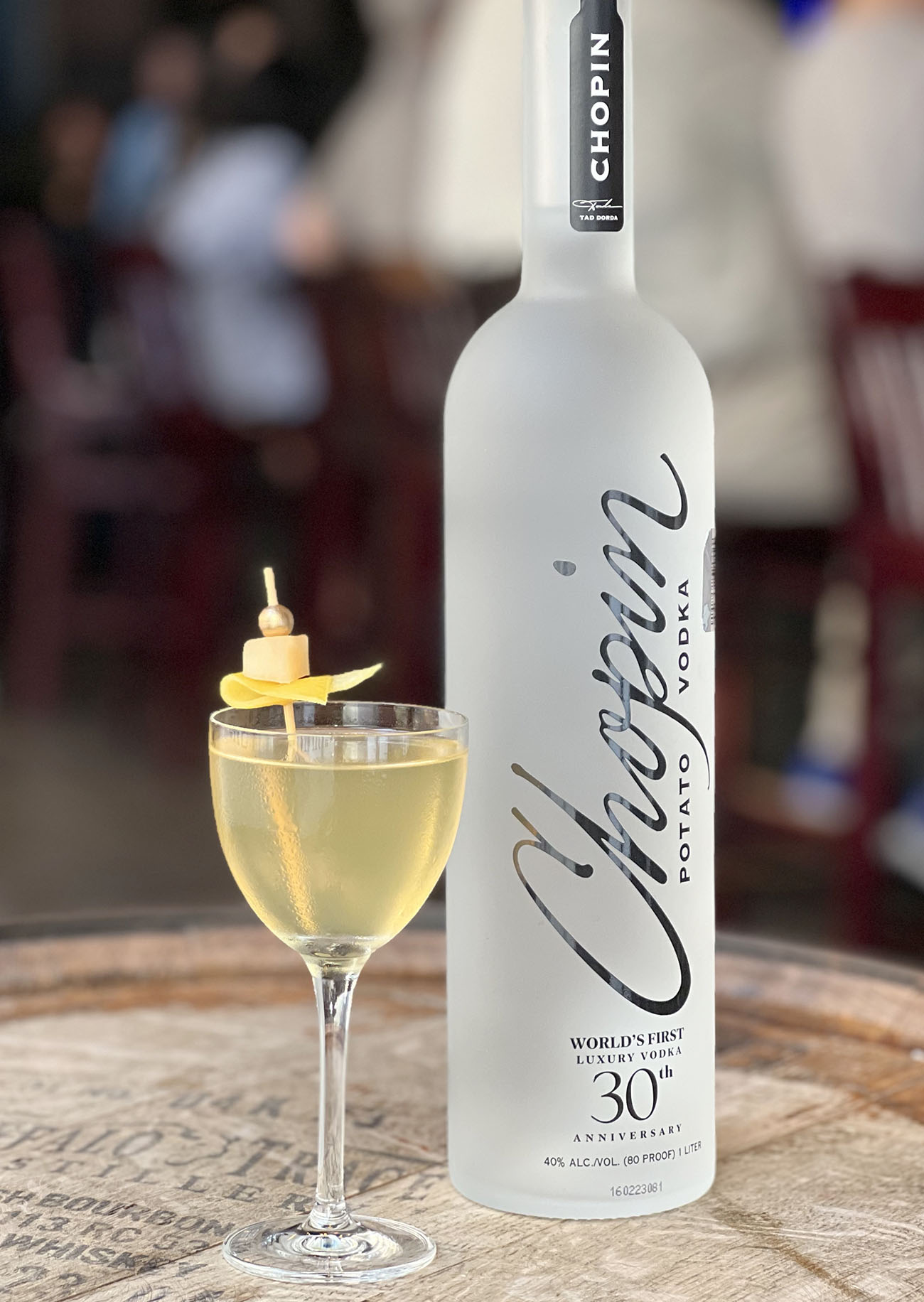
Summer Magic
Ingredients:
- 1 3/4 oz Chopin Potato Vodka
- 3/4 oz Prosciutto Blanc vermouth*
- 1/4 oz Amaro Nonino
- 2 Bar Spoon (scant .25 oz) Melon syrup**
- 1 Bar Spoon (⅛ oz) White Balsamic Vinegar
- 2 Dash Orange bitter (Regans)
Preparation: Build in a stirring glass or tin, add ice and stir to dilute, Strain into a chilled Nick and Nora glass, frozen if possible. Garnish with Hami melon (sub cantaloupe if not available) and manicured lemon zest picked together.
*Prosciutto Blanc Vermouth
Ingredients:
- 375 ml (12.68 oz) Dolin Blanc Vermouth
- 80 g Prosciutto
Preparation: Combine in a vacuum seal bag. Chamber seal or vacuum seal carefully. Sous-vide at 110 degrees for 40 minutes. Drop immediately into an ice bath. Strain off the Prosciutto. Transfer to the freezer for 1 hour to solidify any fats. Strain through the coffee filter to remove all solids. Store in the refrigerator for 1 week.
*Melon Syrup
(yields 12 ounces)
Ingredients:
- 200g Hami Melon (if available, if not double then Cantaloupe)
- 200g Cantaloupe
- 400g Sugar
Preparation: Cut Melons in half, remove and discard the seeds with a spoon, remove the skin with a knife. Cube and measure the fruit. Add fruit and sugar to a blender and blend on high until sugar is dissolved. Fine mesh strain the mixture. Then coffee filter that mixture to get as much pulp removed as possible. Allow to strain slowly overnight in the refrigerator to extract as much as possible. Give a light squeeze if you cannot wait overnight. Store in the refrigerator for 1 week.
Chopin Potato Vodka
2nd Place
Michael Vander Horn – Little Egg Harbor, NJ
Looking deep into the production of a spirit is an incredible way to find inspiration. When it comes to Chopin Vodka’s most popular expression, one does not have to look too far. It’s not often that I read a description of the aroma of a spirit and wholeheartedly agree but with this one, I do. There is subtle green apple and vanilla mixed with perhaps just a touch of something earthier coming through on the nose of this vodka. Licor 43’s complex vanilla pairs with Cynar’s darker earthiness while light touches of absinthe and cardamom amplify the layers of these flavors. At the heart of this lively Cider is of course green apples, adjusted with citric and ascorbic acid to amplify the sour note to pair with a contrast of pistachio orgeat. All together this is a ridiculously refreshing yet balanced serve that brings together the elements of Chopin Potato Vodka’s in a way that allows the full-bodied flavor of the spirit to shine through. Cheers!
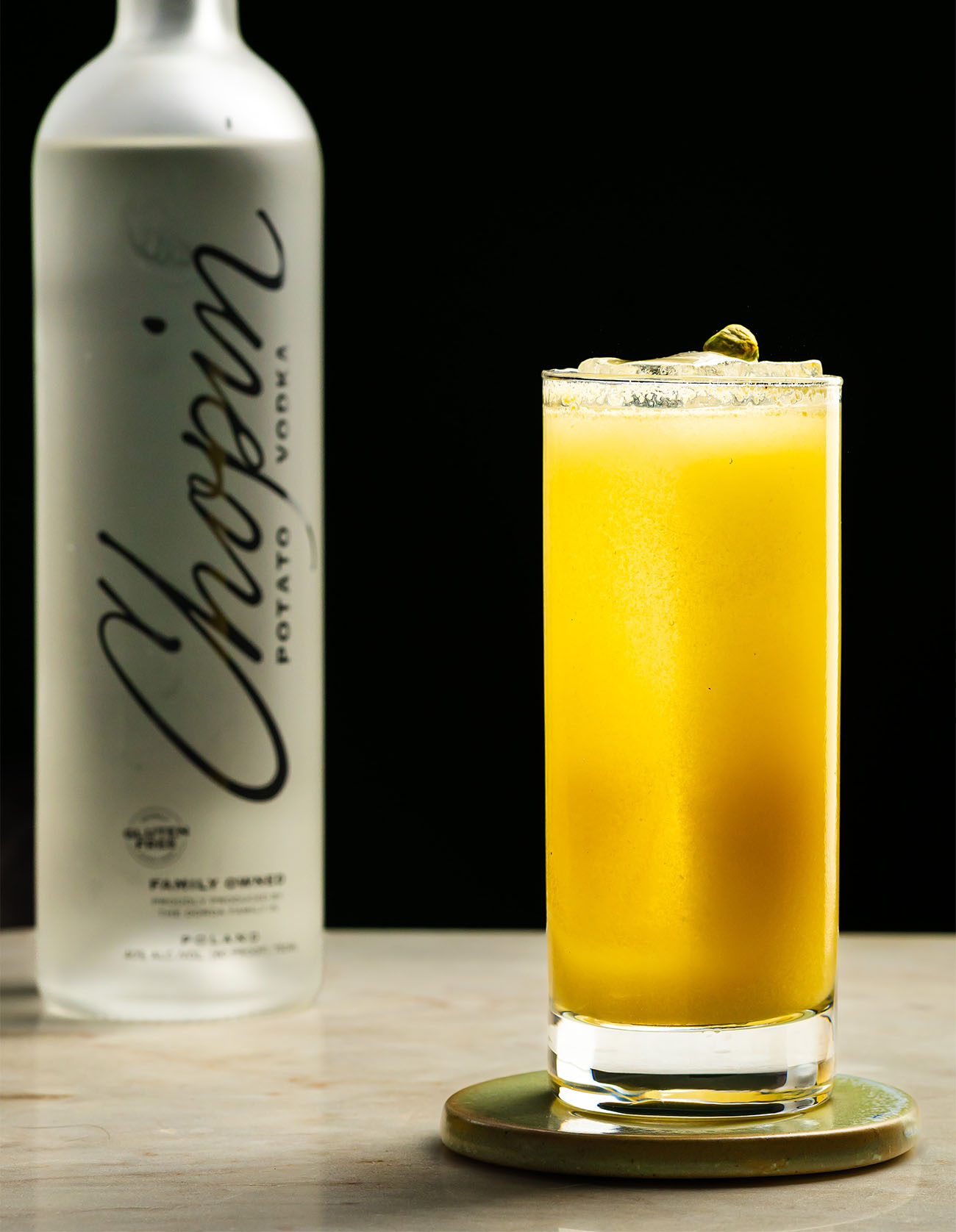
Earth, Wind, and Cider
Ingredients:
- 1 1/2 oz Chopin Potato Vodka
- 1/2 oz Licor 43
- 1/4 oz Cynar 70
- 1 1/2 oz Acid-Adjusted Green Apple Juice*
- 3/4 oz Pistachio Orgeat**
- 2 Dashes Absinthe
- 2 Dashes Scrappy’s Cardamom Bitters
- Top with Club Soda
Preparation: Add all ingredients to a shaker tin and short shake. Strain into a highball glass over a clear ice spear. Top with club soda and garnish with a pistachio.
*Juice one large green apple and add 12 drops of citric acid solution and two drops of ascorbic acid solution. Stir and taste, adjust as needed
**Add 100g shelled, unsalted pistachios to a blender with 1 1/2 cups near boiling water and blend for 2 minutes. Strain through cheese cloth or a nut milk bag into a clean container. Rinse blender and add nut mixture back with 1 1/8 cups sugar and a teaspoon of rose water. Blend for 1 minute and add to a clean container. Store in fridge for up to 1 month.
Chopin Rye Vodka
1st Place
Jonathan Stanyard
Chopin is known for being the last family-owned vodka brand in Poland. Beyond that, they are a luxury vodka brand focusing on a single grain in each expression. I was inspired by the Rye Vodka’s touch of spice, nice body, and crisp and clean finish. I built a spirit-forward drink to honor the vodka’s nuance of aromatic rye. The fruitiness of strawberries and the kick of pink peppercorn blend wisely with a bittersweet aperitivo and dry sherry. The finish of lemon bitters mist lets the cocktail begin fresh, with bitters notes. As you enjoy the cocktail, it becomes softer and sweeter. The throwing technique gives a perfect balance of chilled and diluted while maintaining the body and mouthfeel of the drink. This is a luxurious sip for the Last Family Standing.

Last Family Standing
Ingredients:
- 1 1/2 oz Chopin Rye Vodka
- 3/4 oz Strawberry-Pink peppercorn infused Cocchi Americano*
- 1/2 oz Cappelletti Aperitivo
- 1/4 oz Fino Sherry
- 2 spritzes of Scrappy’ s Black Lemon Bitters
Preparation: Add all ingredients except the bitters into the large part of a mixing tin. Fill with ice and throw the cocktail between the large and small container by holding the ice back with a stemmed Hawthorne strainer. Throw the drink between the two five times, then strain it into a well-chilled cocktail glass. (You could also stir the cocktail softly.) Mist the bitters across the cocktail and garnish with a fresh lemon peel and strawberry slice. Garnish with lemon peel and fresh strawberry
*Strawberry-Pink peppercorn infused Cocchi Americano
Ingredients:
- 1/2 lb. Fresh Strawberries (Quartered)
- 10 g Pink Peppercorns
- 375 ml Cocchi Americano
Preparation: Combine all the ingredients in an airtight container and place them in the refrigerator. Let infuse for 48 hours. Strain and keep in the refrigerator.
Chopin Rye Vodka
2nd Place
Suzy Tweten – Los Angeles, CA
Take your taste buds on a journey with this multi-cultural play on a martini. I wanted to create a savory cocktail that would appeal to a variety of tastes—the goal was to center the supporting players around Chopin’s rye vodka, which has notes of crushed red pepper and aromas of rye bread. I wanted to show off that this vodka can offer incredible complexity and play well in a variety of craft cocktails. I have chosen to split the dry vermouth component in order to achieve both a light salinity and a savory, earthy intensity. Fino sherry brings sea-like salinity, clean and fresh, with a slight taste of tangy yeast to bring out those rye bread notes in the vodka. Dry umami vermouth is a mix of kombu seaweed, porcini mushrooms, and an array of botanicals to give this an unbelievable savory depth that pairs beautifully with the peppery zing from Chopin.
A small amount of dashi (Japanese soup stock) is added for those dirty Martini vibes and to amplify the umami present in the vermouth. Banana notes are in the background via a bit of banana liqueur, offering a contrasting sweetness and balance to the savory. Yuzu bitters bring a hint of citrus notes and perceived acidity, and it’s all topped with the aroma and texture of a few drops of toasted sesame oil. If you haven’t had the combination of crushed red pepper, sesame, banana, and umami, I beg you to do your tastebuds a favor and give it a try! It even comes with a snack of a brûléed banana slice topped with nori furikake for a sweet-savory delight.
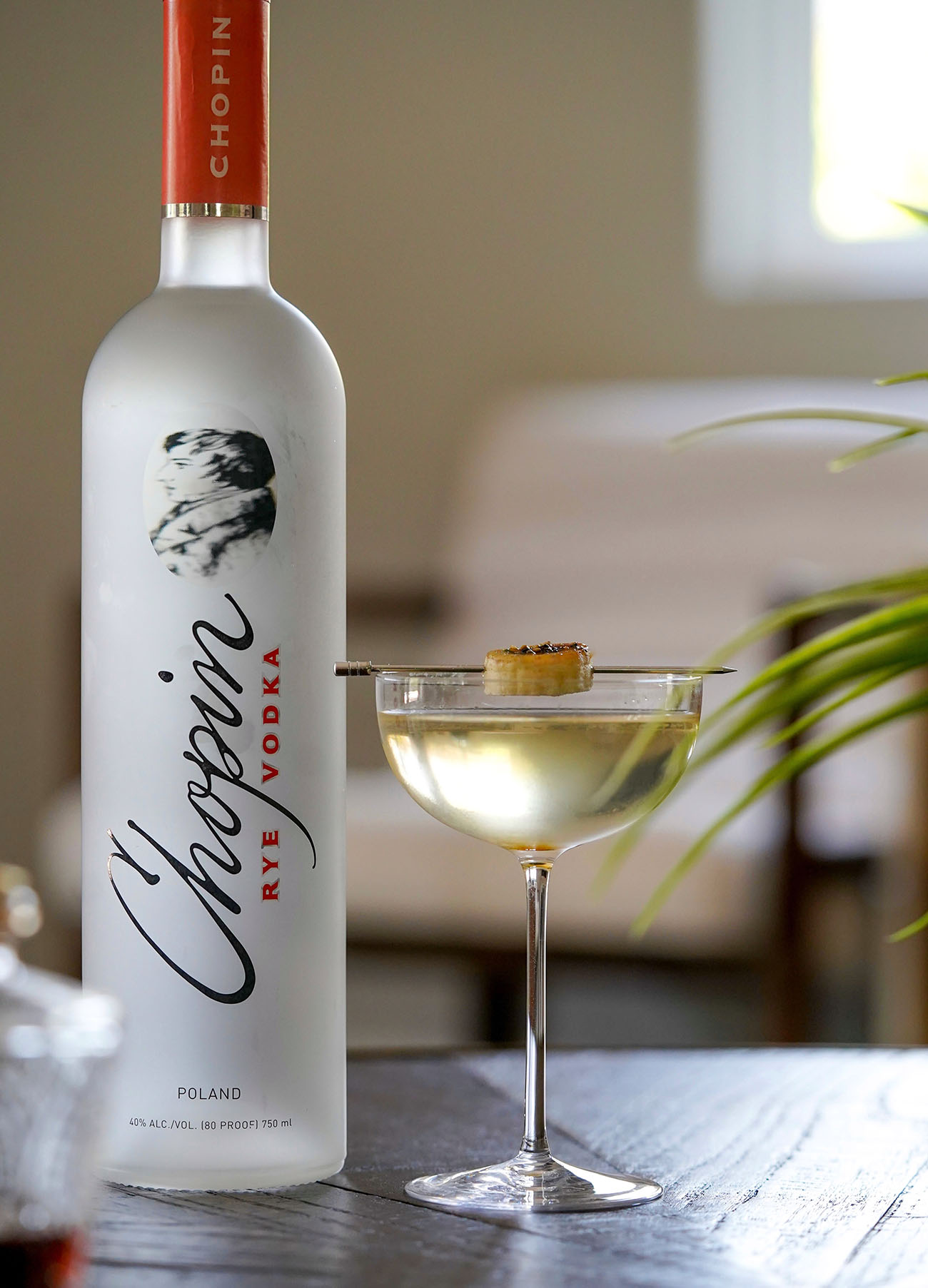
Dirty Yard Dash
Ingredients:
- 2 oz Chopin Rye Vodka
- 1/2 oz Dry Umami vermouth
- 1/2 oz Fino sherry
- 1/4 oz Banana liqueur
- Teaspoon Vegan Dashi (Shiitake Kombu Dashi)*
- 2 dashes Yuzu bitters
- 3 drops Toasted sesame oil, for garnish
Preparation: Combine all except sesame oil in a mixing glass with ice and stir until well chilled. Strain into a chilled coupe. Garnish with 3 drops of toasted sesame oil, and a brûléed banana slice
*Dashi
1 piece kombu (10 g), 2 pieces dried shiitake mushrooms, 4 cups water. Steep for 5 hours in fridge and strain.
Chopin Wheat Vodka
1st Place
Jonathan Stanyard – Seattle, WA
The Chopin Wheat Vodka is so fresh and light I built a recipe to pair flavors that would complement and not overwhelm it. There are pleasant floral aromas and a sweet caramel flavor profile in the vodka that I focused on. A rich and bright apple-coconut cordial is balanced with fresh yuzu and bergamot. To add another layer of aromatics, a touch of fragrant pear brandy. Altogether, this cocktail is like walking through a blooming apple or pear orchard or reminds me of my walks this spring through my neighborhood. What’s in a name? As the saying goes, an apple a day keeps the doctor away; this cocktail has a bit of that and, more importantly, makes one feel well with its bright and refreshing nature.

Alive & Well
Ingredients:
- 1 3/4 oz Chopin Wheat Vodka
- 3/4 oz Apple-Coconut Cordial*
- 1/2 oz Pear Brandy
- 1/4 oz Yuzu Juice
- 3 dashes Bergamot Bitters
Preparation: Add all the ingredients into a cocktail shaker, and fill with ice. Shake for 12 seconds and fine strain into a chilled Nick and Nora glass. Garnish with a fresh apple fan.
Apple-Coconut Cordial*
Ingredients:
- 200g Coconut Water
- 125g Green Apple
- 150g Cane Sugar
- ½ of a Vanilla Bean
- 3g Citric Acid
- 3g Malic Acid
Preparation: Add the coconut water to a saucepan and simmer over medium-low heat. Thinly slice the green apple and add it to the pan. Split and scrape the vanilla bean and add to the pan. Cover and simmer over very low heat for 30 minutes. Add the sugar and stir to dissolve. Cover and let come to room temp off the heat. Add to a blender and blend until smooth. Filter through a fine mesh strainer to remove the pulp. Add the acids and store them in an airtight container.
Chopin Wheat Vodka
2nd Place
Suzy Tweten – Los Angeles, CA
Frédéric Chopin was a Polish composer and virtuoso noted for his solo piano music. Chopin produced some of piano’s most intimate, romantic works during his lifetime. Born in Poland and died in France, he was one of the foremost Romantic era composers of the 19th century.
I wanted to create a cocktail that reflected both his life and his work and dedicate this to what I feel are Chopin’s most romantic compositions, his Nocturnes. Despite the name, many of these 21 beautiful compositions feel particularly light, and the delicacy defies the technical challenge in playing them. I wanted my cocktail to evoke that feeling of delicate lightness, but with underlying complexity—and Chopin Wheat vodka was the perfect base with which to achieve this.
Chopin Wheat is delicate, clean, and light. Its aromas of anise and citrus bring out a subtle sweetness that is made for bright, fruit-based cocktails. This martini variation utilizes ingredients both from Poland and France, balancing the dryness of the vodka and vermouth with a touch of sweetness from a French melon aperitif.
Infusing the vermouth with tarragon lends an herbal quality that highlights the anise notes in the vodka. The Provence melon (Charentais melon) is like a vibrant cantaloupe and is amazingly fresh tasting in aperitif form. The melon-tarragon pairing is a match made in heaven, only improved upon by a hint of pink peppercorn to add a floral, fruity bite that amplifies the floral aromas in the vodka. The garnish lends a lovely aroma via fresh tarragon; and the pansy flower is said to represent the thoughts of lovers, named for the French word for “thought” (pensée)—the flower completes the romance-themed libation.
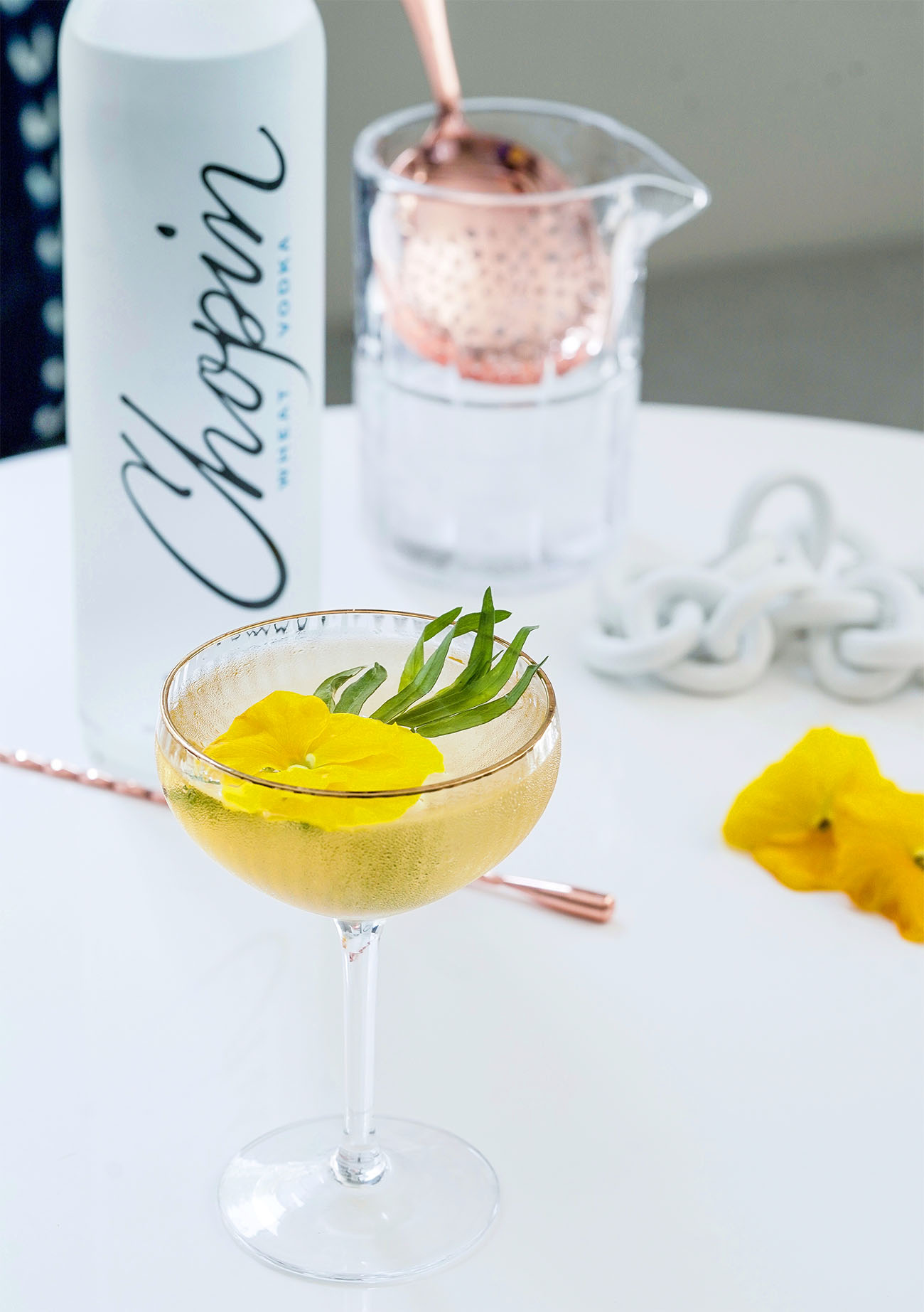
Nocturne
Ingredients:
- 2 oz Chopin Wheat vodka
- 3/4 oz Tarragon-infused dry vermouth*
- 1/4 oz Cavaillon Melon aperitif
- Dash pink peppercorn tincture**
Preparation: Combine all ingredients in a mixing glass with ice and stir until well chilled. Strain into a chilled coupe, and garnish with fresh tarragon and an edible pansy. Garnish with fresh tarragon and pansy flower
*Tarragon infused dry vermouth
Ingredients:
- 100 grams fresh tarragon
- 350 ml Dolin Dry vermouth
Preparation: Combine in an airtight container and infuse refrigerated for 24 hours.
Strain and keep refrigerated
**Pink peppercorn tincture
- 5 grams pink peppercorns
- 250 ml high proof neutral spirit
Preparation: Steep for 24 hours at room temperature. Strain into dropper bottle and keep indefinitely.
The post Check Out the Winners of the Chopin Vodka Cocktail Competition appeared first on Chilled Magazine.
Source: Mixology News















































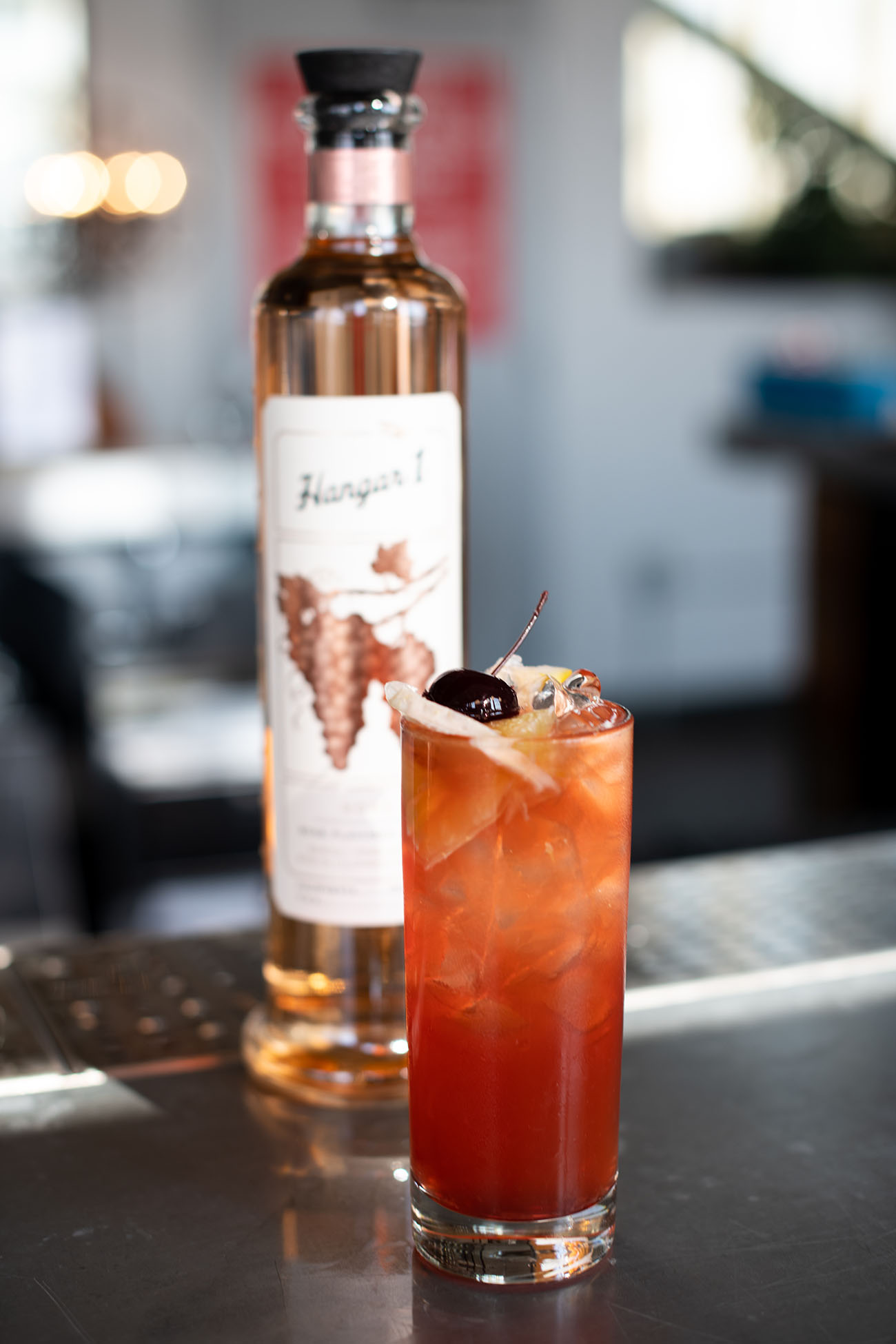


Recent Comments